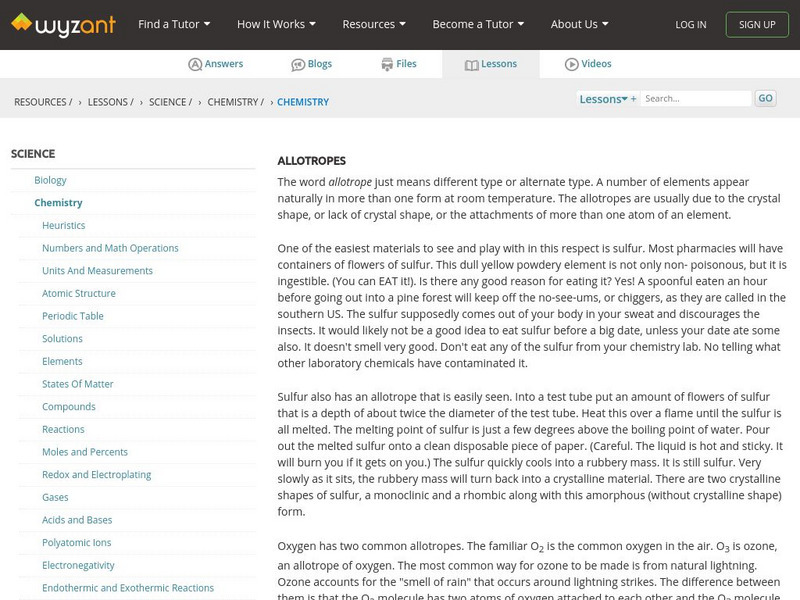Crescent Public Schools
The Internet Science Room: Chemical Formulas
This illustrated tutorial serves as a foundation for understanding chemical formulas in chemistry.
Mocomi & Anibrain Digital Technologies
Mocomi: Difference Between Elements and Compounds
Find out the difference between elements and compounds, the types of compounds, and how to write a compound formula.
Khan Academy
Khan Academy: Test Prep: Mcat: Chemical Processes: Stereochemistry: Chiral Drugs
Explains the concept of chirality and how it is applied in the development of pharmaceuticals.
CK-12 Foundation
Ck 12: Life Science: 2.1 Elements and Compounds
Learn how basic elements form molecules to support life.
Cosmo Learning
Cosmo Learning: Chemical Structure and Reactivity
A collection of video lectures from a professor at the University of California, Berkeley for a chemical structure and reactivity course. The course teaches about aromatic compounds, electronic spectroscopy, and the reactivity and...
Alabama Learning Exchange
Alex: Chemistry Is Colorful!!!
In this lesson, students are introduced to the 5 major types of chemical reactions. Each reaction type will be analyzed and specific examples will be noted. Students will then perform a lab investigation which includes each of the...
Science Struck
Science Struck: What Is Solvent Extraction and Why Is It Important?
Discusses the importance of solvent extraction, provides examples, looks at the importance of appropriate solvent selection, describes the conditions needed for extraction, and explains some of the methods used.
Florida-Spectrum Environmental Services
Florida Spectrum: Chemical Fact Sheet: Manganese
A concise summary of manganese, its properties, uses and compounds.
Science Buddies
Science Buddies: Measuring the Amount of Acid in Vinegar by Titration
There are many different types of vinegar that you can buy to use around the kitchen for cooking and pickling. The chemical compound that gives vinegar its tart taste and pungent smell is acetic acid. In this experiment you will work to...
University of Colorado
University of Colorado: Ph Et Interactive Simulations: Molarity
What determines the concentration of a solution? Learn about the relationships between moles, liters, and molarity by adjusting the amount of solute and solution volume. Change solutes to compare different chemical compounds in water.
Other
Science Alive: Synthetic vs. Natural: What's the Difference?
Explains the difference between a synthetic compound and one found in its natural state. Uses the example of Percy Julian and Josef Pikl making the compound physostigmine, a medicine that was used in the treatment of glaucoma, in their lab.
Towson University
Towson University: Drawing Lewis Structures
Brief rules for writing Lewis structures for simple compounds. Some examples are included.
Science Buddies
Science Buddies: Solubility Science: How Much Is Too Much?
In this science activity, you will find out how much of a compound is too much to dissolve.
Utah Education Network
Uen: Reactions!
Students use colored marshmallows (representing atoms) to construct compounds and arrange them into a balanced chemical equation.
Wyzant
Wyzant: Chemistry: Terms
This lesson provides a list of chemical terms, defines them, and uses examples to describe and explain each. These include allotropes, ionic compounds, methane, carbon dioxide, alkali flats, blue vitriol, and others.
Science Struck
Science Struck: Composition of Air
Discover all the elements and chemical compounds that are found in the air. They are presented in a chart listing their symbols, molecular weights, and what percent of the atmosphere they each comprise. A set of facts is also provided.
Science Struck
Science Struck: Potassium Hydroxide and Sodium Hydroxide
Learn what the difference is between potassium hydroxide and sodium hydroxide and what they are each used for.
Science Buddies
Science Buddies: Do Milkweed Bugs Show a Color Preference for Egg Laying Sites?
Milkweed bugs, as their name suggests, have a close relationship with the milkweed plant. The plant produces a milky sap, and toxic compounds, but somehow the milkweed bug is unaffected by them. Instead, it concentrates chemicals from...
Other popular searches
- Naming Chemical Compounds
- Chemical Compounds of Food
- Chemical Compounds in Cells
- Types of Chemical Compounds
- Atoms in Chemical Compounds
- Forming Chemical Compounds
- Chemical Compounds for Life
- Ionic Chemical Compounds
- Chemical Compounds and Bonds
- Chemical Compounds of Life
- Chemical Compounds Molecules








